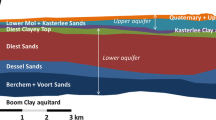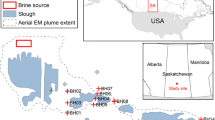Abstract
Spatial variations in hydraulic conductivity (K) are a primary control on contaminant movement in groundwater, but characterization of these variations has proven difficult. Over the last two decades, significant progress has been made in utilizing Direct Push (DP) technology to characterize K variations in unconsolidated settings. Profiling methods have been developed based on empirical correlations between K and more readily evaluated formation properties and on the formation response to water injection or extraction. The latter (hydraulic) methods appear to have the most potential. Initial work on these methods involved adaptation of conventional well tests, but recent efforts have better exploited DP capabilities. The High-Resolution K and continuous Direct Push Injection Logger (DPIL) methods are the most promising approaches. Both provide high-resolution (0.015 m) K profiles, although the DPIL profile is only qualitative in nature. Currently, the K range of both is approximately 0.001 to 60 m/d, but that range should increase in the near future.
Zusammenfassung
Die räumliche Verteilung der hydraulischen Durchlässigkeit (K) bestimmt maßgeblich den Schadstofftransport im Grundwasser, lässt sich aber durch Messungen nur schwer erfassen. In den letzten zwei Jahrzehnten gab es jedoch mit dem Einsatz von Direct Push (DP) deutliche Fortschritte, um Verteilungen von K in unverfestigten Sedimenten zu ermitteln. So wurden Methoden zu ihrer Erfassung entwickelt, die auf empirischen Beziehungen zwischen K und einfach zu ermittelnden Untergrundeigenschaften beruhen und solche, für die Wasserinjektions- oder Extraktionsversuche genutzt werden, wobei letztere am erfolgversprechendsten sind. Ursprüngliche Ansätze beruhen dabei auf der Durchführung von konventionellen Versuchen mit DP-Ausrüstung. Neuere Entwicklungen erlauben es aber, die Möglichkeiten von DP besser auszunutzen, von denen das ,,High Resolution K“ und kontinuierliche ,,DP Injection Logging“ dabei die am erfolgversprechendsten sind. Beide Methoden erlauben hochauflösend K-Profile (0,015 m) in einem Anwendungsbereich zwischen ca. 0,001 und 60 m/d zu ermitteln. Zukünftig ist zu erwarten, dass dieser Bereich mit neuen Geräteentwicklungen und Verfahren sich erweitern wird.






Similar content being viewed by others
References
Baligh, M.M., Levadoux, L.N.: Pore pressure dissipation after cone penetration. Report R80-11, Dept. of Civil Engineering, Massachusetts Institute of Technology, Cambridge, Massachusetts (1980)
Boggs, J.M., Young, S.C., Beard, L.M., Gelhar, L.W., Rehfeldt, K.R., Adams, E.E.: Field study of dispersion in a heterogeneous aquifer. 1. Overview and site description. Water Resources Research 28(12), 3281–3291 (1992)
Bohling, G.C., Liu, G., Knobbe, S.J., Reboulet, E.C., Hyndman, D.W., Dietrich, P., Butler, J.J. Jr.: Comparative geostatistical analysis of flowmeter and centimeter-scale direct-push hydraulic conductivity profiles at the MADE Site (abstract). In: Proc. of NovCare 2011, p. 6 (2011)
Brauchler, R., Butler, J.J. Jr., Aufman, M.S., McKay, S.E., Healey, J.M., McCall, G.W., Knobbe, S.J.: Direct-push cross-hole slug tests: A new tool for hydraulic characterization of aquifers (abstract). Eos 85(47), Fall Meet. Suppl., Abstract H21E-1049 (2004)
Butler, J.J. Jr.: The Design, Performance, and Analysis of Slug Tests. Lewis Publishers, Boca Raton (1998)
Butler, J.J. Jr.: A simple correction for slug tests in small diameter wells. Ground Water 40(3), 303–307 (2002)
Butler, J.J. Jr.: Hydrogeological methods for estimation of hydraulic conductivity. In: Rubin, Y., Hubbard, S. (eds.) Hydrogeophysics, pp. 23–58. Springer, Berlin (2005)
Butler, J.J. Jr., Healey, J.M., McCall, G.W., Garnett, E.J., Loheide, S.P.: Hydraulic tests with direct-push equipment. Ground Water 40(1), 25–36 (2002)
Butler, J.J. Jr., Dietrich, P., Wittig, V., Christy, T.: Characterizing hydraulic conductivity with the direct-push permeameter. Ground Water 45(4), 409–419 (2007)
Dagan, G., Neuman, S.P.: Subsurface Flow and Transport: A Stochastic Approach. Cambridge University Press, Cambridge (1997)
Dietrich, P., Leven, C.: Direct push technologies. In: Kirsch, R. (ed.) Groundwater Geophysics, pp. 321–340. Springer, Berlin (2005)
Dietrich, P., Butler, J.J. Jr., Faiss, K.: A rapid method for hydraulic profiling in unconsolidated formations. Ground Water 46(2), 323–328 (2008). doi:10.1111/j.1745–6584.2007.00377.x
Douglas, B.J., Olsen, R.S.: Soil classification using electric cone penetrometer. Cone Penetration and Experience (ASCE National Convention), American Society of Civil Engineers (ASCE), St. Louis, pp. 209–227 (1981)
Farrar, J.A.: Research and standardization needs for direct push technology applied to environmental site characterization. In: Morgan, J.H. (ed.): Sampling Environmental Media, ASTM special technical publication 1282, pp. 93–107. American Society for Testing and Materials, Philadelphia (1996)
Fogg, G.E., Carle, S.F., Green, C.: Connected network paradigm for the alluvial aquifer system. In: Zhang, D., Winter, C.L. (eds.): Theory, Modeling, and Field Investigation in Hydrogeology: A Special Volume in Honor of Shlomo P. Neuman’s 60th Birthday. Geological Society of America Special Paper 348, pp. 25–42 (2000)
Grunewald, E., Walsh, D., Turner, P., Butler, J.J., Knight, R., Reboulet, E., Knobbe, S., Christy, T.: Field demonstration of nuclear magnetic resonance (NMR) logging tools for groundwater and environmental investigations (abstract). In: Symposium on the Application of Geophysics to Engineering and Environmental Problems (SAGEEP) (2011)
Henebry, B.J., Robbins, G.A.: Reducing the influence of skin effects on hydraulic conductivity determinations in multilevel samplers installed with direct-push methods. Ground Water 38(6), 882–886 (2000)
Hinsby, K., Bjerg, P.L., Andersen, L.J., Skov, B., Clausen, E.V.: A mini slug test method for determination of a local hydraulic conductivity of an unconfined sandy aquifer. J. Hydrol. 136(1–4), 87–106 (1992)
Jacob, C.E.: Drawdown test to determine effective radius of artesian well. Trans. Am. Soc. Civil Eng. 112(2312), 1047–1070 (1947)
Kruseman, G.P., de Ridder, N.A.: Analysis and evaluation of pumping test data, ILRI Pub., vol. 47. Int. Inst. for Land Reclamation and Improvement, The Netherlands (1990)
Lessoff, S.C., Schneidewind, U., Leven, C., Blum, P., Dietrich, P., Dagan, G.: Spatial characterization of the hydraulic conductivity using direct-push injection logging. Water Resources Research 46, W12502 (2010). doi:10.1029/2009WR008949
Leven, C., Weiß, H., Vienken, T., Dietrich, P.: Direct-Push-Technologien – Effiziente Untersuchungsmethoden für die Untergrunderkundung. Grundwasser 16(4), 1–14 (2011). doi:10.1007/s00767-011-0182-9
Liu, G., Bohling, G.C., Butler, J.J. Jr.: Simulation assessment of the direct-push permeameter for characterizing vertical variations in hydraulic conductivity. Water Resources Research 44, W02432 (2008). doi:10.1029/2007WR006078
Liu, G., Butler, J.J. Jr., Bohling, G.C., Reboulet, E., Knobbe, S., Hyndman, D.W.: A new method for high-resolution characterization of hydraulic conductivity. Water Resources Research 45, W08202 (2009). doi:10.1029/2009WR008319
Lowry, W., Mason, N., Chipman, V., Kisiel, K., Stockton, J.: In-situ permeability measurements with direct push techniques: Phase II topical report. SEASF-TR-98-207 Rept. to DOE Federal Energy Tech. Center, 102 pp. (1999)
Lunne, T., Robertson, P.K., Powell, J.J.M.: Cone Penetration Testing in Geotechnical Practice. Blackie Academic and Professional, London (1997)
McCall, W., Nielsen, D.M., Farrington, S., Christy, T.M.: Use of direct-push technologies in environmental site characterization and ground-water monitoring. In: Nielsen, D.M. (ed.) The practical handbook of environmental site characterization and ground-water monitoring, 2nd ed., pp. 345–472. CRC Press, Boca Raton (2005)
McCall, W., Christy, T.M., Christopherson, T., Issacs, H.: Application of direct push methods to investigate uranium distribution in an alluvial aquifer. Ground Water Monit. Remediat. 29(4), 65–76 (2009)
Paradis, D., Lefebvre, R., Morin, R.H., Gloaguen, E.: Permeability profiles in granular aquifers using flowmeters in direct-push wells. Ground Water 49, 534–547 (2011)
Pitkin, S.E., Rossi, M.D.: A real time indicator of hydraulic conductivity distribution used to select groundwater sampling depths (abstract). Eos 81(19), 239 (2000)
Purvance, D.T., Andricevic, R.: On the electrical-hydraulic conductivity correlation in aquifers. Water Resources Research 36, 2905–2913 (2000)
Robertson, P.K., Campanella, R.G., Gillespie, D., Greig, J.: Use of piezometer cone data. In: In Situ ’86: Use of In Situ Tests in Geotechnical Engineering (ASCE Specialty Conference), pp. 1263–1280. American Society of Civil Engineers (ASCE), Blacksburg (1986)
Schulmeister, M.K., Butler, J.J. Jr., Healey, J.M., Zheng, L., Wysocki, D.A., McCall, G.W.: Direct-push electrical conductivity logging for high-resolution hydrostratigraphic characterization. Ground Water Monit. Remediat. 23(3), 52–62 (2003)
Sellwood, S.M., Healey, J.M., Birk, S., Butler, J.J. Jr.: Direct-push hydrostratigraphic profiling: Coupling electrical logging and slug tests. Ground Water 43(1), 19–29 (2005)
Slater, L., Lesmes, D.P.: Electrical-hydraulic relationships observed for unconsolidated sediments. Water Resources Research 38(10), (2002). doi:10.1029/2001WR001075
Stienstra, P., van Deen, J.K.: Field data collection techniques—unconventional sounding and sampling methods. In: Rengers, N. (ed.) Engineering Geology of Quaternary Sediments, pp. 41–55. Balkema, Rotterdam (1994)
Walsh, D., Turner, P., Frid, I., Shelby, R., Grunewald, E., Butler, J.J. Jr., Johnson, C.D., Cannia, J., Woodward, D., Williams, K., Lane, J.W.: Field demonstration of slim-hole borehole nuclear magnetic resonance (NMR) logging tool for groundwater investigations (abstract). Eos 91(52), Fall Meet. Suppl., Abstract NS23A-1455 (2010)
Zemansky, G., McElwee, C.D.: High-resolution slug testing. Ground Water 43, 222–230 (2005)
Zschornack, L., Bohling, G.C., Butler, J.J. Jr., Dietrich, P.: Numerical assessment and evaluation of the Direct Push Permeameter for characterization of small-scale variations in hydraulic conductivity (abstract). In: Proc. of NovCare 2011, p. 62 (2011)
Acknowledgements
Portions of the work reported here were supported by the Hydrologic Sciences Program of the U.S. National Science Foundation (grant EAR-0738955) and the U.S. Department of Energy, Office of Science (award DE-SC0004623). Any opinions, findings, and conclusions or recommendations expressed are those of the authors and do not necessarily reflect the views of NSF or DoE. This paper greatly benefited from comments provided by two anonymous reviewers.
Author information
Authors and Affiliations
Corresponding author
Rights and permissions
About this article
Cite this article
Liu, G., Butler, J.J., Reboulet, E. et al. Hydraulic conductivity profiling with direct push methods. Grundwasser 17, 19–29 (2012). https://doi.org/10.1007/s00767-011-0182-9
Received:
Revised:
Published:
Issue Date:
DOI: https://doi.org/10.1007/s00767-011-0182-9




